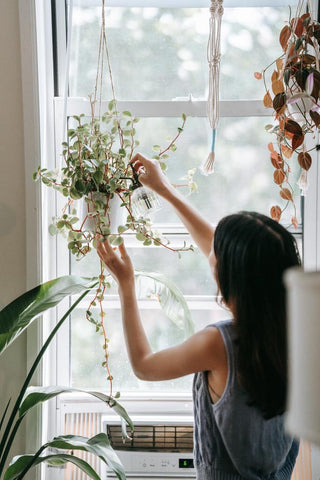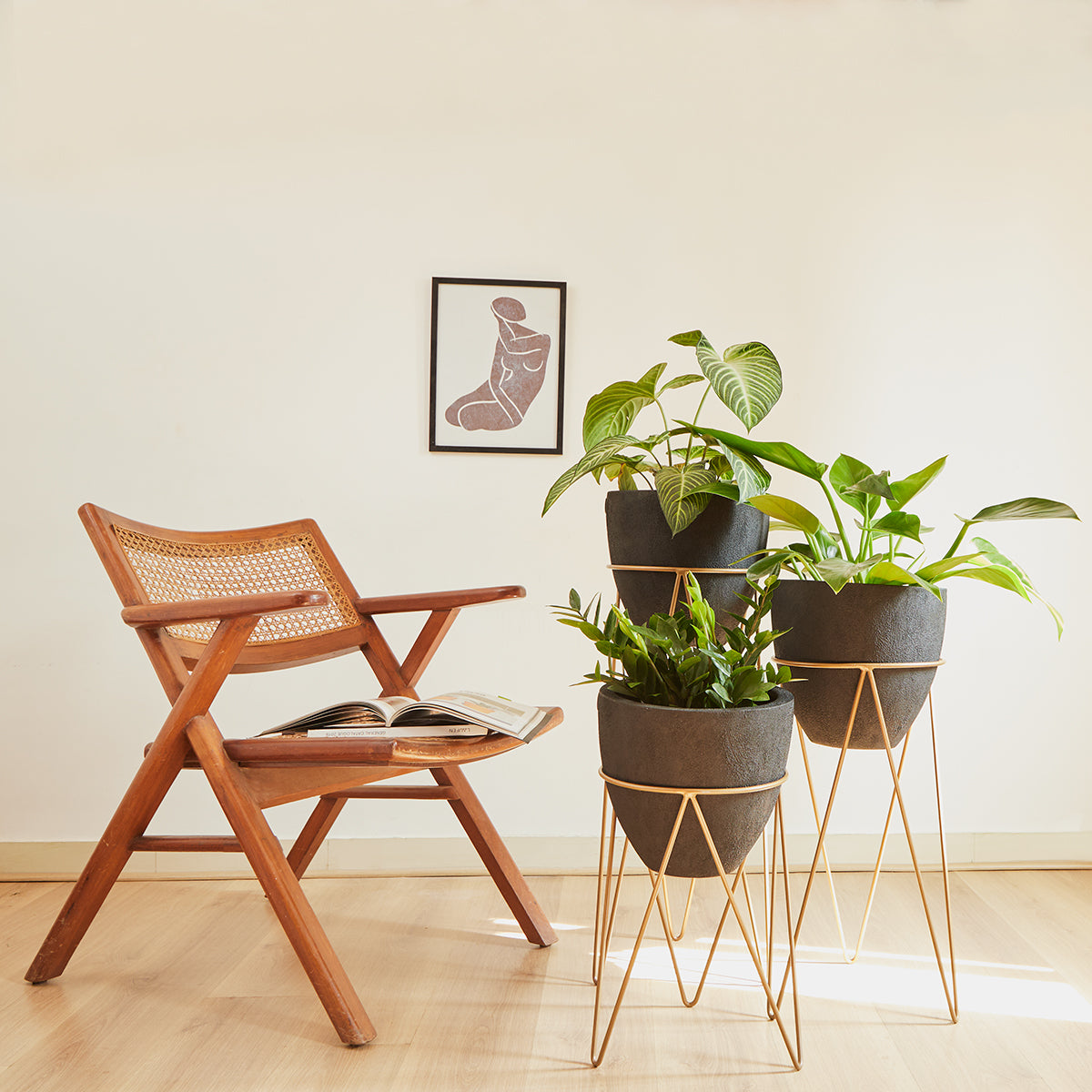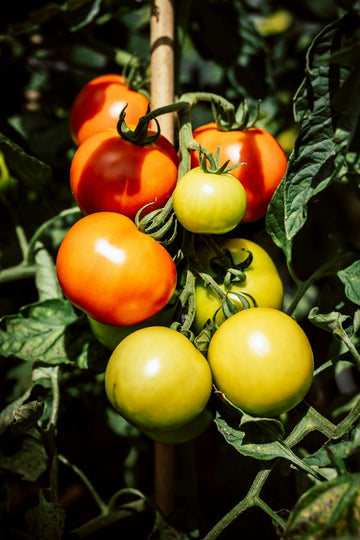Are you tired of seeing your indoor plants wilt and wither away despite your best efforts to keep them alive? Don't worry, you're not alone! One of the most common mistakes people make when it comes to plant care is improper watering. But fear not, because we're here to help you master the art of watering your indoor plants! In this post, we'll share some simple yet effective tips and tricks to help you keep your green friends hydrated and healthy.
So Grab a Watering Can, and Let's Dive In!
Understanding Plants' water needs | Choosing the Right Watering Tools | Factors That Impact Watering for Your Indoor Plants | Watering Tips for Specific Types of Indoor Plants | Common watering Problems | Planter Recommendations
Let's Understand Your Plants' Water Needs

First off, it's important to understand that different plants have different water requirements. Some plants, like succulents, prefer dry soil and only need to be watered sparingly, while others, like ferns, need consistently moist soil. The size of your plant's pot also plays a role in its water needs. Plants in larger pots generally need to be watered less frequently than those in smaller pots.
Another key factor in your plants’ water requirements is the environment it's in. Plants that are exposed to more sunlight and warmer temperatures will need to be watered more often than those in cooler, shadier environments. Humidity levels can also affect a plant's water needs. In general, plants in drier environments will need more water than those in humid environments.
So, how do you know when your plant needs watering? One of the best ways to assess your plant's water needs is to check the soil moisture level. Stick your finger about an inch into the soil and see how it feels. If the soil feels dry, it's time to water your plant. If it feels moist, wait a little longer before watering. Another way to tell if your plant needs water is to observe its behavior. Wilting or drooping leaves can be a sign that your plant is thirsty.
Remember, overwatering can be just as harmful to your plant as underwatering. Always err on the side of caution and make sure your plant's soil has had a chance to dry out between waterings. And don't forget to water your plants thoroughly. A little bit of water here and there won't do the trick. Water your plant until water starts to drain out of the bottom of the pot.
(back to top)
Choosing the Right Watering Tools and Techniques

When it comes to watering tools, there are a few different options to choose from. The most common tool is a watering can, which is great for watering larger plants and those that need a good amount of water. Watering cans usually have a spout that allows you to direct the water right into the soil around your plant's base. Another tool to consider is a spray bottle, which is perfect for watering smaller plants and for misting plants that require higher humidity levels. Spray bottles allow you to control the amount of water you're using and can help prevent overwatering.
Now, let's talk about some different techniques for watering your indoor plants. One popular technique is bottom watering, which involves placing your plant's pot in a tray or dish filled with water. The soil in the pot will soak up the water from the bottom, ensuring that the roots are getting enough water without overwatering the soil. This technique is especially useful for plants that are prone to root rot or that have sensitive foliage that shouldn't get wet, such as the ZZ plant, snake plant, or rubber plant.
Another technique to consider is misting. This involves using a spray bottle to mist the foliage of your plants, providing them with extra moisture and humidity. Misting is particularly useful for plants that require high humidity levels, such as ferns or orchids. However, be careful not to mist your plants too often (and don’t mist your succulents at all!) as this can lead to fungal growth and other issues.
(back to top)
Factors That Impact Watering for Your Indoor Plants
The frequency with which you water your plants is heavily influenced by many factors. Watering on a schedule isn't wise due to these factors -
-
Plant type: Different plants have different water requirements. Succulent plants, for instance, store water in their leaves and stems, and so do not need to be watered as often as other plants. In contrast, plants such as ferns, alocasia, and tropical plants need more frequent watering as they require consistently moist soil.
- Planter size: The size of your plant's pot also influences watering frequency. Plants in smaller planters dry out more quickly than those in larger planters. Thus, smaller planters will require more frequent watering.
-
Time of year: During the summer months, when temperatures are higher and the air is drier, plants require more frequent watering. In contrast, during the winter months when temperatures are cooler, plants will require less water.
- Environmental conditions: Environmental conditions such as humidity and air circulation can also impact the watering frequency. Plants in low-humidity environments or stagnant air may require more frequent watering to prevent soil from drying out.
- Soil type: Soil that drains well will dry out more quickly than soil that retains moisture, requiring more frequent watering. In contrast, soil that retains moisture will require less frequent watering.
(back to top)
Watering Tips for Specific Types of Indoor Plants

Not all indoor plants have the same water requirements. Some plants, like succulents, require very little water, while others, like ferns and alocasia, need to be kept consistently moist. Here's a guide on how to water some common types of indoor plants and meet their unique water requirements.
- Succulents: Succulent plants are known for their water-storing capabilities, and they require infrequent watering. Water your succulents deeply but infrequently, allowing the soil to dry out completely before watering again. As a general rule, water your succulents once every two to three weeks during the growing season and even less frequently during the dormant season.
- Ferns: Ferns are known for their love of humidity and require consistently moist soil. Water your ferns thoroughly, ensuring the soil is damp but not waterlogged. Be sure to check the soil moisture level regularly to avoid overwatering or underwatering.
- Alocasia: Alocasias like to be kept evenly moist, but not waterlogged. So, make sure the top inch of the soil is dry before watering again. Water thoroughly, until water starts to drain out of the bottom of the pot. This ensures that the entire root system is hydrated. Make sure to empty any excess water that collects in the saucer or tray underneath the pot. Standing water can lead to root rot.
(back to top)
Troubleshooting Common Watering Problems
Overwatering or underwatering your plants can lead to various problems that can damage or even kill your plants. Here are some common watering problems that indoor plants can face, and how to prevent and treat them.
Root rot: Root rot occurs when the roots of a plant are exposed to too much water, causing them to become waterlogged and rot. Signs of root rot include yellowing leaves, wilting, and a foul odor coming from the soil. To prevent this, make sure your plants are not sitting in standing water, and only water them when the top inch of soil is dry. If you suspect root rot, remove the plant from the pot and cut away any rotted roots. Repot the plant in fresh soil and adjust your watering practices.

Leaf drop: Leaf drop can occur when a plant is overwatered, underwatered, or exposed to inconsistent watering practices. Leaves may turn yellow or brown before dropping off. To prevent leaf drop, ensure your plant is getting the right amount of water for its specific needs, and avoid sudden changes in watering frequency.

Mold and mildew: Overwatering and high humidity can lead to mold and mildew growth on the surface of the soil and leaves. To prevent mold and mildew, ensure your plant has adequate drainage and is not sitting in standing water. Consider using a fan or opening a window to increase air circulation and reduce humidity.

(back to top)
Planters recommended for Your Indoor Plants
Discover more planters for your Indoor Plants










 At Palasa, we believe in the seamless fusion of nature, design and humanity.
At Palasa, we believe in the seamless fusion of nature, design and humanity.